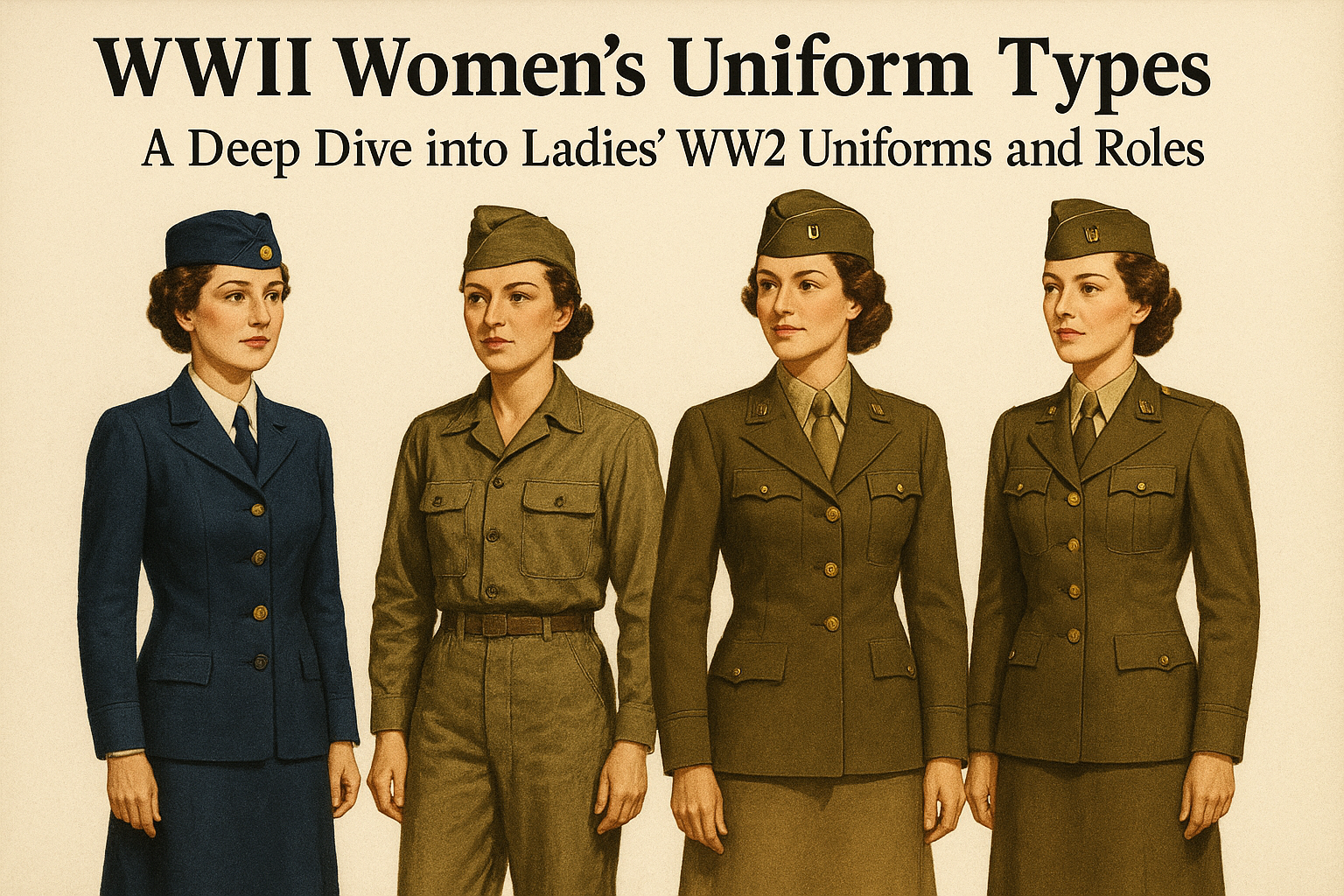
WWII Women’s Uniform Types: A Deep Dive into Ladies' WW2 Uniforms and Roles
Published on May 26, 2025
WWII Women’s Uniform Types: A Deep Dive into Ladies' WW2 Uniforms and Roles
The Second World War marked a turning point not just in global politics but also in the role of women across the military and industrial landscape. As thousands of men were deployed to the frontlines, women stepped into roles that were previously off-limits—including military service. One of the most compelling aspects of this change was the introduction of various WWII women’s uniforms tailored to different responsibilities and branches. Today, these uniforms are not only historical artifacts but symbols of resilience, dedication, and change.
In this guide, we’ll explore the various types of ladies WW2 uniforms, including Army Nurse uniforms, WW2 HBT uniforms, AGSU (Army Green Service Uniform), and relevant army uniform regulations.
1. The Rise of Women in WWII Military Service
Before diving into uniform specifics, it’s essential to understand the context. WWII created an urgent need for personnel, and women stepped up in large numbers. Organizations like the Women’s Army Corps (WAC), Army Nurse Corps, and Navy WAVES offered women the opportunity to serve—often in challenging and demanding conditions.
With this new responsibility came the need for practical, functional, and standardized WW2 female uniforms.
2. Army Nurse Uniform: Elegance Meets Duty
Army Nurse Uniforms during WWII were among the first official women’s military outfits. Designed for utility but maintaining a formal appearance, these uniforms often included:
- Navy blue or olive drab skirts and jackets
- White summer service dresses
- Standard issue nursing caps and insignia
Key Features:
- Lightweight for hospital environments
- Clearly marked with rank and Red Cross insignia
- Tailored to allow movement while keeping a professional appearance
Army nurses played critical roles in frontline aid stations, field hospitals, and evacuation units. Their uniforms symbolized courage under fire and were designed for both utility and authority.
👉 Collectible Tip: Original WW2 Army Nurse uniforms are now highly valued by collectors due to their condition, cut, and branch insignia.
3. HBT Uniform: Practicality in the Field
Another crucial type of uniform for women in the war effort was the WW2 HBT uniform (Herringbone Twill). While initially designed for men, modified versions were created for female workers and soldiers.
HBT uniforms were typically worn by women working in:
- Motor pools
- Munitions factories
- Field support operations
Key Features:
- Made from durable cotton twill
- Olive drab or sage green color
- One-piece coveralls or two-piece sets with patch pockets
- Worn with a field cap or utility hat
Women who served in maintenance roles or operated military vehicles often wore these functional outfits. Their toughness made them ideal for dirty and labor-intensive tasks, yet they allowed freedom of movement and resilience.
🧵 Fun Fact: The nickname “HBT” comes from the distinctive herringbone pattern in the fabric weave—a popular design for utility uniforms due to its durability.
4. AGSU Uniform (Army Green Service Uniform)
Though more commonly known in a modern military context, the AGSU (Army Green Service Uniform) has roots in the iconic WWII "Pinks and Greens" uniforms. These were reimagined for modern military personnel but pay homage to the WWII styling.
Key Characteristics:
- Olive-drab jacket with pinkish-tan trousers or skirt
- Tan dress shirt underneath
- Belted waist with brass buttons
- Optional garrison cap
While not strictly part of the original 1940s issue, the AGSU is important for modern collectors and reenactors seeking historically inspired looks that match the WWII era aesthetic. The lineage of this uniform makes it a popular tribute style on paddelaters.com.
5. Understanding Army Uniform Regulation for Women
Uniforms in the military aren’t just about appearance—they follow strict army uniform regulations. In WWII, guidelines were established to ensure consistency and discipline.
Women’s uniform regulations included:
- Proper placement of insignia, patches, and rank
- Skirt lengths and sleeve specifications
- Standardized materials and colors across all branches
- Seasonal versions (summer vs. winter uniforms)
These regulations were meticulously followed, especially for nurses, WACs, and female support staff. Authentic WWII women’s uniforms should reflect these standards, making knowledge of regulation crucial for collectors and reenactors.
6. WW2 Female Uniform Categories by Role
To further understand how women’s uniforms differed, here’s a breakdown by role:
RoleUniform TypeKey ElementsArmy Nurse | Army Nurse Uniform | Blue/olive skirts, white dress, insignia
Mechanics/Drivers | HBT Uniform | One/two-piece cotton, utility pockets
Administrative WACs | Olive Drab Service Dress | Tunic, skirt, garrison cap
Field Operations | HBT or M43 Uniform | Jacket, trousers, combat boots
Ceremonial Staff | AGSU (modern homage) | Dress shirt, pink trousers/skirt
7. Why Ladies WW2 Uniforms Matter Today
The resurgence of interest in WWII women’s uniforms is driven by several communities:
- Military history buffs seeking accuracy
- Collectors preserving vintage militaria
- Cosplayers and reenactors recreating authentic wartime looks
- Fashion historians analyzing practical vintage styles
By understanding these uniform types, we honor the sacrifices and service of women during WWII while also preserving a crucial part of history.
8. Shop Authentic and Reproduction WW2 Female Uniforms
If you're looking to explore or purchase authentic or reproduction WW2 female uniforms, Paddelaters.com offers a wide range of historically accurate pieces, including:
- Authentic-style Army Nurse Uniforms
- Durable and historically designed HBT uniforms
- Stylish AGSU-based garments with vintage appeal
Whether you're building a collection, participating in a reenactment, or diving into the world of wartime fashion, we have something to match your needs.
Conclusion
From the trenches to the hospitals, women in WWII wore their uniforms with pride and purpose. Each stitch, patch, and button told a story of courage and transformation. Understanding the types and history of WWII women’s uniforms not only helps preserve this legacy but keeps it alive for future generations.
Explore our full collection of ladies WW2 uniforms, and wear history with pride
